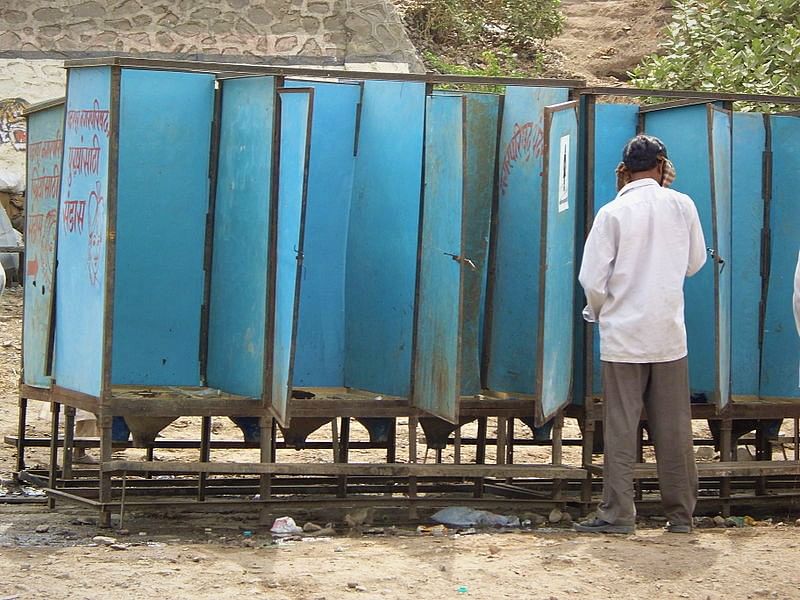Data reveals 25% of Hindus who own toilets don’t use them, only 10% of Muslims do the same.
Far from his dwelling let him remove urine and excreta –The Laws of Manu (a Hindu sacred text), Chapter 4 verse 151
More than half of the Indian population, over 600 million people, defecate in the open, without the use of a latrine or toilet. The prevalence of open defecation (hereafter OD) is particularly high among India’s Hindu majority. Data from the most recent wave of the National Family Health Survey (NFHS) of India show that as of 2005, 68% of Hindu households defecate in the open—e.g., in fields, near streets, or behind bushes. In comparison, only 43% of the relatively poorer Muslim households do so.
To investigate these patterns in more detail, we turn briefly to the Sanitation Quality, Use, Access, & Trends survey, which was collected by one of this study’s authors in rural northern India in 2013 and 2014. Unlike our main analysis dataset, the NFHS, this survey was specifically designed to elicit preferences over latrine use. We use it here to provide a clearer context and understanding of the stark demand differences we exploit below.
Table 1 summarizes responses at the individual and household levels, with Hindu means in column 1 and Muslim means in column 2. Consistent with other data sources, the first row of the table shows that Hindus are significantly more likely than Muslims to practice OD—that is, they are less likely to use a latrine or toilet. This difference in revealed preferences is deeply embedded: The second row shows that a substantial minority of Hindus who reside in a household with a working latrine nonetheless choose to defecate in the open. 25% of Hindus who own functional latrines choose not to use them, compared to 10% of Muslims. These findings are consistent with accounts from Indian commentators and evaluations by researchers that toilets constructed or paid for by the government often remain unused or repurposed by Hindus.
The roots of these behavioural differences are difficult to trace and are beyond the scope of this paper. Sanitation practices may have evolved differently across Muslim and Hindu communities for purely secular reasons, and could have been privately or socially optimal given the context under which they arose. Even specific religious instruction with respect to sanitation and hygiene that we observe today may have been established long ago— codifying then-existing norms, rather than establishing those norms. Regardless of the historical path, we show here that religion is a highly predictive marker for group differences.
While we take no position on whether religion causes OD per se, it is common for Indians to discuss waste disposal choices with reference to religious purity. Row 4 of Table 1 shows that a substantial fraction of both Hindu and Muslim respondents self-report that a religious leader has told them explicitly where to defecate. The last two rows of Table 1 show that Hindus are more likely than Muslims to respond that OD away from the home is pure, while using a latrine near the home is not pure. All Hindu-Muslim differences in the table are statistically significant at the 5% level.
The possibility that open defecation would ever be chosen if a working toilet or latrine were available may be surprising to many readers, but these patterns, and indeed the Hindu-Muslim behaviour difference itself, are well known to many residents of rural India.
Moreover, this behaviour has long been recognized and documented publicly: Cultural scholars attribute the modern persistence of OD among Hindus in India to the persistence of the Hindu caste system, with its ritual avoidance of excreta. Recently, Hindu politicians across the political spectrum have publicly recognized this pattern. And nearly a century ago, Gandhi campaigned to change Indian behaviour with respect to excreta disposal, famously declaring, “Sanitation is more important than independence.”
In short, the prominence of OD among Hindus is not merely a matter of the affordability of latrines and toilets. Instead, Hindus report and reveal clear preferences against using latrines. Indeed, the nationally representative data shows that the Hindu-Muslim demand difference holds at all levels of wealth. This demand difference is key in our identification of the mortality externalities of latrine use.
This is an edited excerpt from May 2015 working paper titled “Neighbourhood sanitation and infant mortality” conducted for the National Bureau of Economic Research, Cambridge, Massachusetts. The full text of the report is available here.
